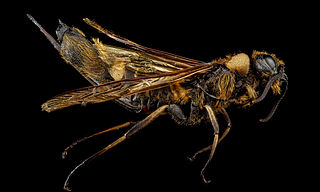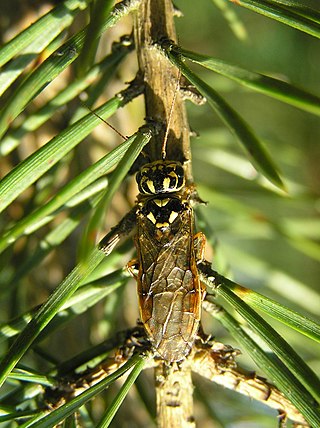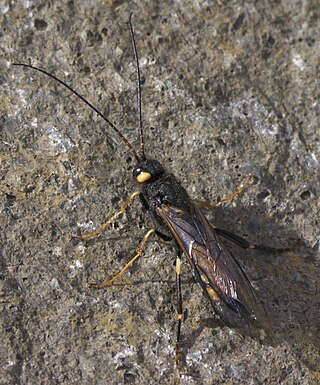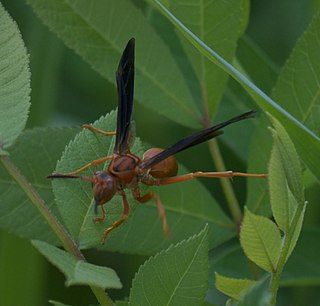
Sawflies are wasp-like insects that are in the suborder Symphyta within the order Hymenoptera, alongside ants, bees, and wasps. The common name comes from the saw-like appearance of the ovipositor, which the females use to cut into the plants where they lay their eggs. The name is associated especially with the Tenthredinoidea, by far the largest superfamily in the suborder, with about 7,000 known species; in the entire suborder, there are 8,000 described species in more than 800 genera. Symphyta is paraphyletic, consisting of several basal groups within the order Hymenoptera, each one rooted inside the previous group, ending with the Apocrita which are not sawflies.

Rhopalosomatidae is a family of Hymenoptera containing about 68 extant species in four genera that are found worldwide. Three fossil genera are known.

Horntail or wood wasp are any of the 150 non-social species of the hymenopteran family Siricidae, a type of wood-eating sawfly. The common name "horntail" derives from the stout, spine-like structure at the end of the adult's abdomen which is present in both sexes. The ovipositor in females is typically longer and also projects posteriorly, but it is not the source of the name. Though they are not wasps, they are sometimes called wood wasps as the appearance of some species resembles one due to mimicry. A typical adult horntail is brown, blue, or black with yellow or red parts, and may often reach up to 4 cm (1.6 in) long. The pigeon horntail can grow up to 5 cm (2.0 in) long, among the longest of all Hymenoptera.

The Orussidae or the parasitic wood wasps represent a small family of sawflies ("Symphyta"). Currently, about 93 extant and four fossil species are known. They take a key position in phylogenetic analyses of Hymenoptera, because they form the sister taxon of the megadiverse apocritan wasps, and the common ancestor of Orussidae + Apocrita evolved parasitism for the first time in course of the evolution of the Hymenoptera. They are also the only sawflies with carnivorous larvae.

The Xyelidae are a comparatively species-poor family of sawflies, comprising about 80 extant species in five genera worldwide, and is the only family in the superfamily Xyeloidea. The fossil record of the family is extensive, comprising more than 120 species and including the oldest fossil Hymenoptera species dating back to the Triassic, between 245 and 208 million years ago. Xyelidae are to be regarded as living fossils since they represent one of the oldest lineages of insects and include still extant forms.

Cephoidea is a small superfamily within the Symphyta, commonly referred to as stem sawflies, containing some 100 species in 10 genera in the living family, Cephidae, plus another 17 genera in the extinct family Sepulcidae. They first appeared around 212 million years ago in the Norian Age, and are diurnal. Most species occur in the Northern Hemisphere, especially in Eurasia. The larvae are stem borers in various plants, especially grasses, but sometimes other herbaceous plants, shrubs, or trees. A few are pests of cereal grains. They are exceptionally slender for symphytans, often resembling other types of wasps, and they are the only Symphyta which lack cenchri. They are sometimes postulated to be the sister taxon to the Apocrita, though the Orussidae are more commonly considered such.

The Megalodontesidae are a small family of sawflies, containing a single living genus, Megalodontes, with some 40 species restricted to the temperate regions of Eurasia. Larvae of Megalodontesidae feed on herbaceous plants. They are distinguished from the closely related Pamphiliidae by their serrate or pectinate antennae.

Pamphiliidae is a small family within Symphyta, containing some 200 species from the temperate regions of North America and Eurasia. The larvae feed on plants, using silk to build webs or tents, or to roll leaves into tubes in which they feed, thus earning them the common names leaf-rolling sawflies or web-spinning sawflies. Some species are gregarious and the larvae live in large groups. Fossils of Pamphiliidae have been dated to the Jurassic period.
BugGuide is a website and online community of naturalists, both amateur and professional, who share observations of arthropods such as insects, spiders, and other related creatures. The website consists of informational guide pages and many thousands of photographs of arthropods from the United States and Canada which are used for identification and research. The non-commercial site is hosted by the Iowa State University Department of Entomology. BugGuide was conceived by photographer Troy Bartlett in 2003 and since 2006 has been maintained by John VanDyk, an adjunct assistant professor of entomology and a senior systems analyst at Iowa State University. The website has been recognized for helping change the public perception of insects.
Megachile angelarum is a species of bee in the Megachilidae family.

The Thynnidae are a family of large, solitary wasps whose larvae are almost universally parasitoids of various beetle larvae, especially those in the superfamily Scarabaeoidea. Until recently, the constituents of this family were classified in the family Tiphiidae, but multiple studies have independently confirmed that thynnids are a separate lineage.

Pristiphora is a genus of sawfly in the family Tenthredinidae. Some of its species, such as the larch sawfly Pristiphora erichsonii, eat the leaves of economically valuable trees and shrubs, and can be serious pests.

Trogus is a genus of parasitoid wasp found in the Holarctic and Neotropic regions. It is placed in the subfamily Ichneumoninae and the tribe Ichneumonini. Trogus species are parasites of larvae and pupae of the swallowtail butterfly family, Papilionidae. The genus consists of twelve extant and one extinct species.

Urocerus is a genus of horntails in the family Siricidae. There are about eight described species in Urocerus.

Ibalia leucospoides, the knife-shaped ibalia, is a species of ibaliid wasp in the family Ibaliidae.

Ibalia is a genus of ibaliid wasps in the family Ibaliidae. There are about 14 described species in Ibalia. All species are parasitoids of Siricidae species, which they seek out by detecting volatiles emitted by the fungi Siricidae larvae feed on, Amylostereum.

Polistes rubiginosus is one of two species of red paper wasp found in the eastern United States and is noted for the coarser ridges on its propodeum. It is a social wasp in the family Vespidae. Until taxonomic revision by Matthias Buck in 2012, P. rubiginosus was long known under the name P. perplexus. It occurs northernmost from Maryland, Pennsylvania to northern Ohio, south to Florida, and from there west to central Illinois, Kansas, Oklahoma, Texas and Arizona.

Urocerus albicornis is a species of horntail native to North America. This species has occasionally been introduced into Europe and Japan.

Urocerus flavicornis, the yellow-horned horntail wasp, is a species of horntail native to North America.

Megischus is a genus of crown-wasps in the parasitoid family Stephanidae. There are over 90 species globally distributed throughout the Neotropical, Palearctic, Afrotropical, Oriental, Australasian, and Oceanian zoogeographical regions.

















